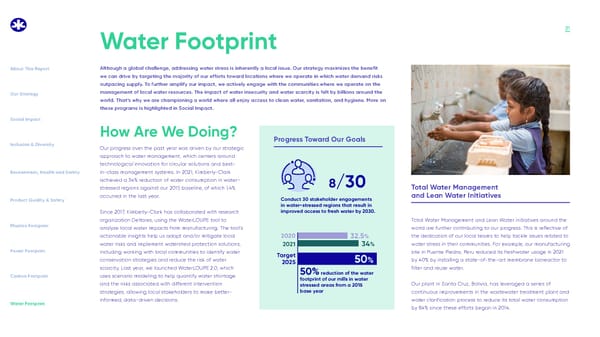21 Our progress over the past year was driven by our strategic approach to water management, which centers around technological innovation for circular solutions and best- in-class management systems. In 2021, Kimberly-Clark achieved a 34% reduction of water consumption in water- stressed regions against our 2015 baseline, of which 1.4% occurred in the last year. Since 2017, Kimberly-Clark has collaborated with research organization Deltares, using the WaterLOUPE tool to analyze local water impacts from manufacturing. The tool’s actionable insights help us adapt and/or mitigate local water risks and implement watershed protection solutions, including working with local communities to identify water conservation strategies and reduce the risk of water scarcity. Last year, we launched WaterLOUPE 2.0, which uses scenario modeling to help quantify water shortage and the risks associated with different intervention strategies, allowing local stakeholders to make better- informed, data-driven decisions. Total Water Management and Lean Water initiatives around the world are further contributing to our progress. This is reflective of the dedication of our local teams to help tackle issues related to water stress in their communities. For example, our manufacturing site in Puente Piedra, Peru reduced its freshwater usage in 2021 by 40% by installing a state-of-the-art membrane bioreactor to filter and reuse water. Our plant in Santa Cruz, Bolivia, has leveraged a series of continuous improvements in the wastewater treatment plant and water clarification process to reduce its total water consumption by 84% since these efforts began in 2014. Although a global challenge, addressing water stress is inherently a local issue. Our strategy maximizes the benefit we can drive by targeting the majority of our efforts toward locations where we operate in which water demand risks outpacing supply. To further amplify our impact, we actively engage with the communities where we operate on the management of local water resources. The impact of water insecurity and water scarcity is felt by billions around the world. That’s why we are championing a world where all enjoy access to clean water, sanitation, and hygiene. More on these programs is highlighted in Social Impact. How Are We Doing? Total Water Management and Lean Water Initiatives Water Footprint Conduct 30 stakeholder engagements in water-stressed regions that result in improved access to fresh water by 2030. Progress Toward Our Goals 8 /30 50% reduction of the water footprint of our mills in water stressed areas from a 2015 base year Target 2025 2020 2021 32.5 % 34 % 50 % About This Report Social Impact Our Strategy Inclusion & Diversity Environment, Health and Safety Product Quality & Safety Plastics Footprint Forest Footprint Carbon Footprint Water Footprint
 Kimberly-Clark Global Sustainability Report Page 20 Page 22
Kimberly-Clark Global Sustainability Report Page 20 Page 22